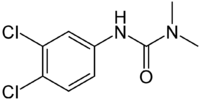Difference between revisions of "Diuron"
| Line 1: | Line 1: | ||
| + | === === | ||
{{Definition|title=diruon | {{Definition|title=diruon | ||
| Line 30: | Line 31: | ||
[[List of priority substances|Included in the water framework list of priority substances]] | [[List of priority substances|Included in the water framework list of priority substances]] | ||
| + | |||
| + | |||
| + | <BR> | ||
| + | == See also == | ||
| + | |||
| + | [http://www.vliz.be/projects/endis/EDnorth.php?showchemprop=true&showeffects=true&chemeffects=true&chemid=251 Diuron on the ED North Database] | ||
<P> | <P> | ||
<BR> | <BR> | ||
Revision as of 09:47, 17 August 2009
Definition of diruon:
Diuron is used as a herbicide on a variety of both crop and non-crop areas. It is also used as a mildewcide in paints and stains, and as an algaecide in commercial fish production. [1]
This is the common definition for diruon, other definitions can be discussed in the article
|
Notes
| Diuron |
|---|

|
| Formula |
| C9H10Cl12N2O |
In the USA diuron has been used since 1967. Durion is mainly used on citrus, berries, asparagus and pineapple. Right-of-way applications (e.g., the area around railroad tracks) are the greatest non-agricultural use of diuron, with approximately 1 million kilograms applied annually.
In water durion has a low tendency to adsorb to particles and organic matter, dispite its has a relatively low water solubility of 42 mg/l. It's a stable molecule in terrestrial systems but can be biodegraded by micro-organisms. It is expected to be much less stable in aquatic systems, where it's concentration might be halved in 30 days (according to lab experiments). Although it has a low potential towards bioaccumulation, it probably doesn't bioaccumulate or biomagnify in wild aquatic populations. [2]
It has a low toxicity for mammals, doses above 3,4 g per kg body weight are needed to induce acute toxicity. There is a higher for aquatic organisms: some fish species die at concentrations above 4,3 mg/l and some marine invertebrate species may die at concentrations above 1 mg/l. [3]. Algae are most vulnerable to the herbicide, it can be toxic for some algae species at concentrations of only 5 µg/l. [4]
Environmental standards and legislation
Included in the water framework list of priority substances
See also
Diuron on the ED North Database